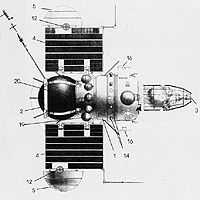 | |
| Mission type | Venus lander |
|---|---|
| Operator | OKB-1 |
| Harvard designation | 1962 Alpha Pi 1[1] |
| COSPAR ID | 1962-040A |
| SATCAT no. | 372 |
| Mission duration | Launch failure |
| Spacecraft properties | |
| Spacecraft type | 2MV-1 |
| Manufacturer | OKB-1 |
| Launch mass | 890 kilograms (1,960 lb) |
| Power | watts |
| Start of mission | |
| Launch date | 25 August 1962, 02:18:45 UTC |
| Rocket | Molniya 8K78 s/n T103-12 |
| Launch site | Baikonur 1/5 |
| End of mission | |
| Decay date | 28 August 1962 |
| Orbital parameters | |
| Reference system | Geocentric |
| Regime | Low Earth (achieved) Heliocentric (intended) |
| Eccentricity | 0.00403 |
| Perigee altitude | 168 kilometres (104 mi) |
| Apogee altitude | 221 kilometres (137 mi) |
| Inclination | 64.9 degrees |
| Period | 88.71 minutes |
| Epoch | 25 August 1962 |
Venera 2MV-1 No.1,[2][1] also known as Sputnik 19 in the West, was a Soviet spacecraft, which was launched in 1962 as part of the Venera programme.
Due to a problem with its upper stage it failed to leave low Earth orbit, and reentered the atmosphere a few days later.[3] It was the first of two Venera 2MV-1 spacecraft, both of which failed to leave Earth orbit.[1]
- ^ a b c Krebs, Gunter. "Venera (2a), (2b) (2MV-1 #1, 2)". Gunter's Space Page. Retrieved 28 July 2010.
- ^ Cite error: The named reference
LLwas invoked but never defined (see the help page). - ^ Wade, Mark. "Venera". Encyclopedia Astronautica. Archived from the original on 11 December 2016. Retrieved 28 July 2010.